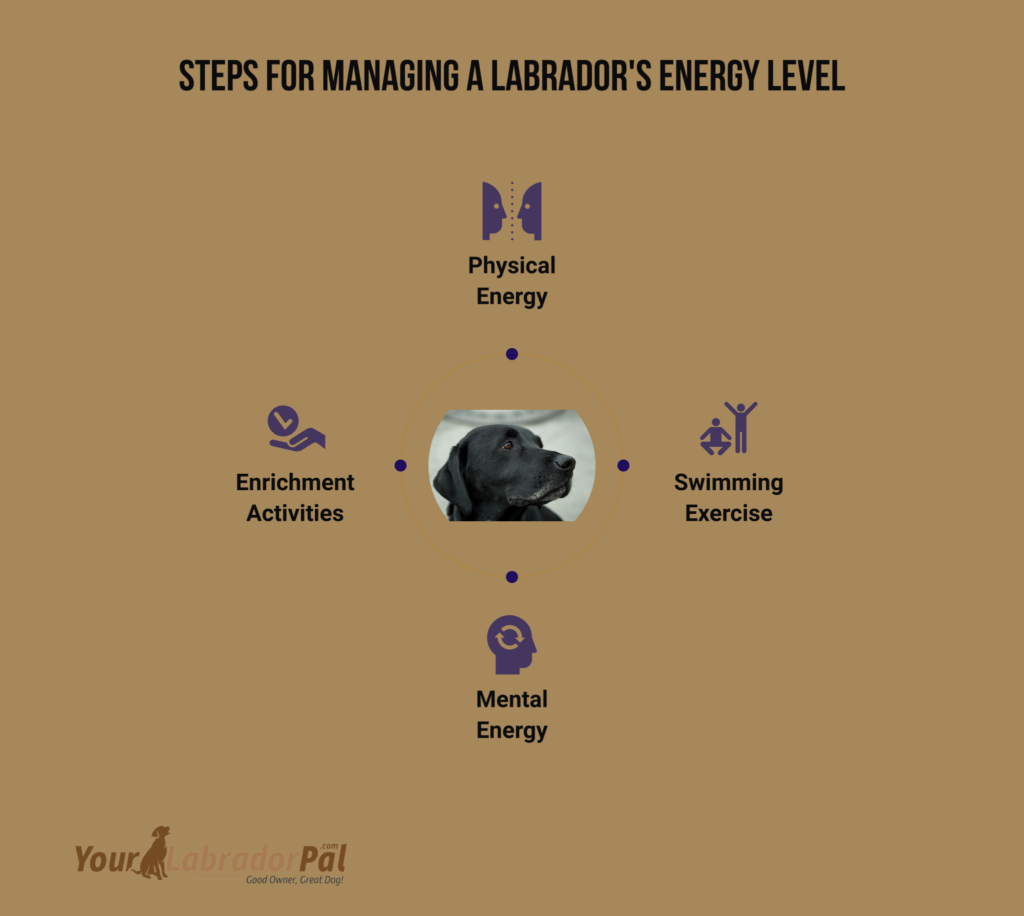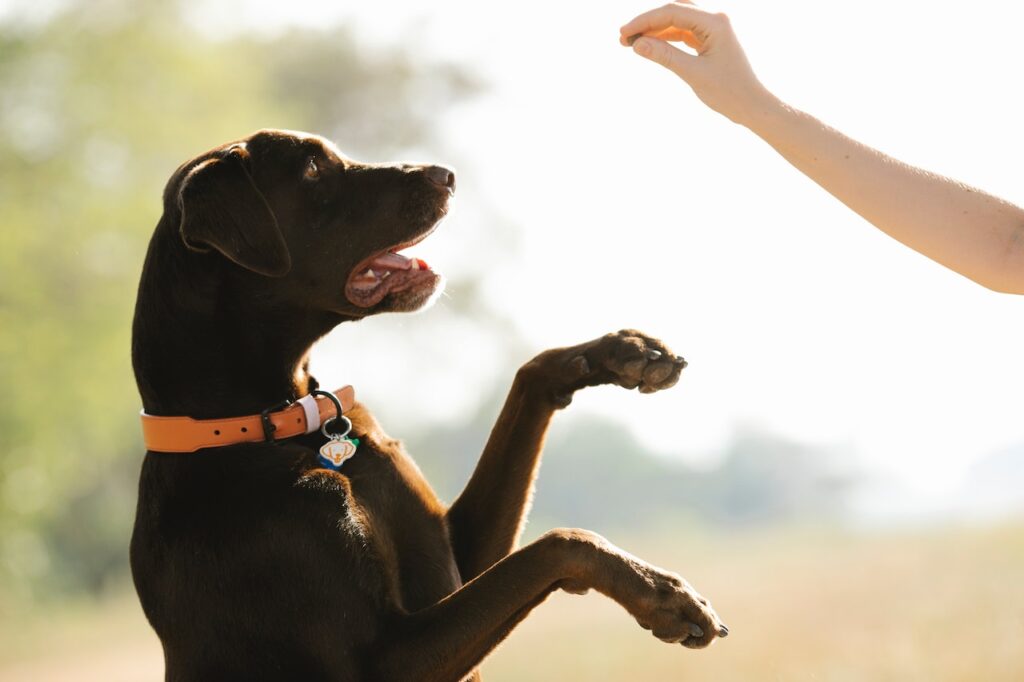Exploring the High Energy Levels of Labrador Retrievers
Do you want to know the Labrador Retriever’s energy level? The Labrador retriever is a breed that combines appearance, intellectual capacity, and physical ability. This breed has become popular because of its amiable personality, timeless charm, and cognitive capabilities. Although Labradors make great family pets, their teenage years can be chaotic manias typical of the breed.
To effectively transfer your Labrador from a juvenile offender to a well-adjusted adult while maintaining your sanity, you must learn how to control their energy. Most Labradors will eventually reach a time where they will naturally slow down. However, the high-energy years before that may be more enjoyable by attending to your Labrador’s needs and guiding their behavior. In this article, I will explore Labrador retriever energy levels. Keep reading for more!
History of Labrador Retrievers
The ancestors of the modern Labrador retriever came from Newfoundland, not Labrador. A breed named the St. John’s water dog also dubbed the smaller Newfoundland, was utilized on fishing boats in the early 1800s. These canines were well-known for their skill in the water, dedication to their jobs, and friendliness.
The dogs piqued the curiosity of visiting British nobility in Newfoundland. Some were transported back to England as gun dogs for hunting ducks. As the breed disappeared in Newfoundland, they kept improving it in England. Finally, they developed the breed standard we are familiar with today.
The Labrador retriever was approved by the American Kennel Club in 1917. And in recent years, the Lab has routinely been recognized as one of the most famous dog breeds in the U.S. Throughout history, several well-known people have Labradors, including Bill Clinton, Prince William, and Prince Harry. Additionally, laboratories have been crucial to the police, military, and service industries.
The Labrador Retriever’s Characteristics
Despite occasionally being mistaken as an overweight couch potato, this Labrador retriever is strong and active. Their full hunting powers emerge when they are adequately nourished and exercised. They will play games such as fetch for hours since they are natural retrievers. A medium to big dog, the Labrador has friendly eyes and a short, thick coat. The three hues that they often come in are black, yellow, & brown (sometimes known as “chocolate”), while some breeders are now creating “silver” labs. Yellow labs can be virtually white or a deep reddish gold color.
Their double-layered, water-resistant jackets are ideal for swimming. Their short jackets helped in the frigid Canadian winters by preventing the formation of icicles. Additionally, the Labrador retriever has a unique tail that tapers like an otter’s to aid in turning in the water.
🐕Energy Level
The Labrador has become such a well-liked family pet that its athletic and active nature is sometimes neglected. These dogs require a lot of activity for their physical and mental well-being. Long walks on field paths or tracks through forests are ideal for helping them burn off energy and build muscle. They may live longer and experience fewer issues due to their weight. Young labs frequently retain vitality for up to three years after becoming puppies! A healthy amount of exercise might assist in reducing any undesirable habits that result from boredom.
🐕Training
The Labrador is a smart dog who is known for enjoying food. They may learn more quickly and effectively as a result. Numerous labs are employed for crucial jobs like bomb detection & as service dogs. Even though hunting is no longer their primary occupation, they make excellent hunting dogs because of their intrinsic love of retrieving. They are also excellent at obedience and agility. Almost often, labs are excellent swimmers!
But remember that the Labrador is a very strong and active dog. This implies that they perform best when training is started while they are young. Building a foundation in relationship- and reward-based training may guarantee that kids develop into lovable, controllable people who know how to regulate their energy. Punishment-based teaching is frequently unproductive and disregards the breed’s innate desire to please.
🐕Protective Ability
Despite being large and powerful, labs are also kind and non-territorial. These friendly canines are unlikely to bite humans or other dogs. Even though they are not particularly well-suited for guarding, these characteristics make the Labrador retriever a fantastic choice for a family dog.
🐕Size and Life Expectancy
The Labrador Retriever typically lives between ten and twelve years. As they age, they may develop health problems, including cancer and epilepsy. These problems can reduce their lifespan to seven or eight years. These problems are less likely to affect well-bred dogs. Maintaining your Labrador’s exercise routine and keeping him from getting fat can help to lengthen his life.
The size of the male & female Labradors varies somewhat. Males typically range in height from 22.5 to 24.5 inches, while females are somewhat shorter. Males have a weight limit of 80 pounds. The average female weighs between 55 & 70 pounds.
🐕Intelligence
One of the most intellectual dog breeds in the world is the Labrador Retriever. Because of their intellect, they are simple to teach, but they also need continuous mental stimulation, or they can easily get bored.
🐕Loyalty
This breed is fiercely dedicated to its owner and loved ones and is loyal to a fault. Particularly when they are young, the Lab enjoys receiving attention from its owners. The Labrador Retriever’s calm disposition and readiness to assist those in need make it a great therapy dog.
Steps for Managing a Labrador’s Energy Level
Labradors must be provided with a constructive outlet for their physical and mental energy because they were designed to be clever, energetic working dogs. Here are the steps for managing their energy level.
🐶Physical Energy
Owners must carefully manage the amount and exercise their Labrador receives throughout the first year of life. Forcing Labrador pups to exercise vigorously will permanently harm their developing bones. A Labrador’s safe tolerance for organized exercise (such as leash-free walking) may be determined using the formula:
Age of Labrador (in months) x five minutes = Daily Exercise Requirements
A Labrador puppy who is five months old can enjoy a 25-minute stroll, while a Labrador puppy who is a year old can handle an hour-long walk. A Labrador’s organized exercise may be increased from one to three hours if necessary after 12 months. It is crucial to divide the daily activity into training periods to avoid physical harm and overexertion. Labradors should be given the freedom to manage their activities during downtime freely.
🐶Swimming Exercise
The Labrador breed adores the water! They are water-loving dogs by nature, which shows in their water-resistant coat, expert skill, and enthusiasm for all things aquatic.
The benefits of swimming for Labradors are numerous:
▪Running burns fewer calories than swimming does. Therefore, Labradors will use more energy faster.
▪Juvenile (i.e., eight months & older), adult, & senior Labradors can safely swim or wade in water because swimming does not put undue strain on delicate joints.
▪Early desensitization instills a sense of security and comfort near the water in Labradors.
▪Swimming reduces the chance of overheating, so Labradors continue their daily activity throughout the hot summers.
▪It helps working Labradors become in shape for swimming in time for hunting season.
🐶Mental Energy
Everyone has heard of the Labrador who, while getting lots of exercise every day, is wearing out his owner. These excitable Labradors require a job or an activity where they may employ both their body and minds. The only way to stop a bored Labrador from becoming a havoc machine is to provide them with something worthwhile to do with their excess mental energy. Labradors can increase their cognitive talents, curiosity, and attention through activities that push them to think through an issue.
Labradors who are easily excitable and Labradors who work on production lines benefit from intense exercises like:
▪Gundog instruction
▪Sally Gutteridge’s book on scent training, which may be used to control an excitable dog, is quite educational.
▪Low-level obstacle and agility courses; Labradors shouldn’t be overly pushed to leap.
▪Advanced retrieval instruction Instruction in becoming an “assistance dog,” such as a guide dog
▪High-level trick instruction
🐶Enrichment Activities
Your Labrador can take part in chewing, tracking, digging, & playing that is owner-encouraged and, thus, “legal” because it is not penalized through enrichment activities. Pet Labradors through show lines or recovering Labradors benefit from low- to moderate-intensity enrichment activities, such as:
▪Obedience instruction
▪These snuffle mats and this puzzle dispenser are enrichment toys.
▪Simple trick instruction
Books by Shay Kelly & Allie Bender on the different methods owners may employ to improve the life of their Labradors are thorough and simple to read.
Reasons Why Labrador Retrievers Are Energetic
Labrador Retrievers are well known for having plenty of energy and being lively animals. They are regarded as one of the breeds of dogs with the highest levels of activity and vigor. Their historical heritage as working dogs initially bred to recover games for hunters & fishermen accounts for their high activity levels.
Consider the following important factors while investigating the high energy levels of Labrador Retrievers:
👉Heritage of Working Dogs
In Newfoundland, Canada, Labrador Retrievers were developed as working dogs to retrieve fishing nets and catch fish. They also became well-liked hunting partners, bringing in animals from the land and the ocean. Strong work ethics and a desire to be active have been ingrained in them by their ancestors.
👉Exercise Needs
Labs need a lot of exercise and must move around frequently to keep them happy and healthy. They thrive in households with energetic people who can give them lots of opportunities for play and exercise.
👉Fun-loving Nature
Labradors are naturally lively and friendly animals. They are great companions for those who lead busy lifestyles since they like to fetch, interactive games, & running about.
👉Mental Exercise
Labs require cerebral stimulation in addition to physical activity. Keeping their minds engaged and preventing boredom can be achieved by including them in training, puzzles, or interactive toys.
👉Socialization and Training
For Labrador Retrievers, proper socialization and training are crucial. Early instruction is essential to instill appropriate manners and behavior since their high energy levels might occasionally produce excitable behavior.
👉Retrieval Instincts
Due to their history of hunting, labs have a high retrieving sense. They could be seen picking up and carrying stuff about the house, such as toys, twigs, or even inanimate objects.
👉Water Loving Dogs
Due to their retriever ancestry, many Labradors had a natural affinity for the water. They adore splashing about and swimming, making them the perfect company for water-related activities.
👉Companionship Needs
Labrador Retrievers are friendly dogs who like having people around. If left alone for a long time, they can get bored or agitated, which might result in undesired behaviors.
Consider the following to make sure a Labrador Retriever’s high energy levels are properly managed:
Offer a variety of regular workout programs.
Include interactive games and activities that stimulate the mind.
Participate in activities consistent with their innate inclinations, like swimming or retrieving.
Attend obedience training sessions to establish proper conduct.
Dispense a lot of affection and company.
Remember that every dog is different and that energy levels can vary even within a breed. Make sure you can handle a Labrador Retriever’s active personality and give them the love and care they require if you consider taking one home.
How to Calm an Energetic Labrador Retriever
This breed requires more intellectually demanding activities to wear them out; a simple stroll around the block will probably not happen. Forget the cliché of a Lab retrieving a stick a few times.
✔️Give a Structure
By offering some framework, you can get started. Teach Buddy to sit before being given his breakfast, patted, or having his leash fastened. The Learn to Gain, Say Please program takes a less military approach than the Nobody in Life As Free dog training method, a fantastic training regimen to add to a Lab’s life. Based on the Premack Principle, this application enables structure in your regular contact with your Lab.
✔️Start Working
You might not know that putting a restless Labrador to work can result in fantastic things. The greatest approach to offer these dogs something to do is through sophisticated training and canine sports. Consider signing Buddy up for a sport like dock diving, flyball, agility, musical dog freestyle, or nose work. Try enrolling your friend in field trials & hunt tests if you want to see him do the tasks for which he was bred. The retrieval of dummies or genuine downed birds by these canines is incredible.
✔️Get Active
Undoubtedly, a worn-out Lab is a good Labrador. One of the best things about active dogs is that cerebral stimulation tends to wear them out even more so than exercise. Engage Rover’s intellect with challenging activities like food puzzles. He can be taught to get the newspapers for you. Hide him snacks throughout the home to engage his sense of smell. Since it demands a lot of focus, sniffing is a terrific method to exhaust a dog. Take him outside and let him play at the dog park or swim in a pond. Lastly, be sure to sign him up for a basic training course. Establishing some rudimentary control around interruptions, such as other humans and dogs, is essential.
✔️Go To a Veterinarian
Consult your veterinarian to rule out any medical concerns if your Lab suddenly becomes restless and this is quite from character or if you cannot think of a solid explanation for the behavior. Dogs who are in pain, discomfort, or suffering may become restless. Deep-chested dogs like Labs are susceptible to life-threatening emergencies like bloat, which may make even the calmest dog agitated and worried. On the other hand, if your senior Lab begins being restless and aimlessly roaming the house throughout the night, he may be exhibiting the early symptoms of dog Alzheimer’s disease, which is also known as dog cognitive disorder.
Frequently Asked Questions
Are Labrador retrievers suitable as household pets?
In general, labrador retrievers make wonderful family dogs. They can develop positive interactions with youngsters with the right instruction and socialization.
Do Labrador retrievers have a bad temper?
Labs are normally not aggressive dogs as long as they have had proper training and socialization. They have a propensity to adore others and even show kindness to strangers.
Are Labrador retrievers suitable as indoor pets?
Labs may adjust to apartment living as long as they have adequate daily exercise, fun, and social interaction with their family.
Do Labs have more energy than Golden Retrievers?
Most breeders believe Labradors have a little more energy than Golden Retrievers. As a result, it’s advised that Labradors exercise daily for at least an hour, ideally longer.
Which laboratories are the most active?
More black Labs than any other color have been raised for field trial events. This suggests that compared to Labs of other hues, black Labs tend to have higher levels of energy in the United States.
Final Thoughts
Labrador retrievers exhibit amiable, energetic, and loyal characteristics, making them suitable family companions. Nevertheless, these dogs’ exceptionally elevated energy level needs regular engagement and involvement from owners to prevent any potential issues. Simultaneously, the Labrador retriever is an individual companion that offers recreational and practical benefits within a household setting.






